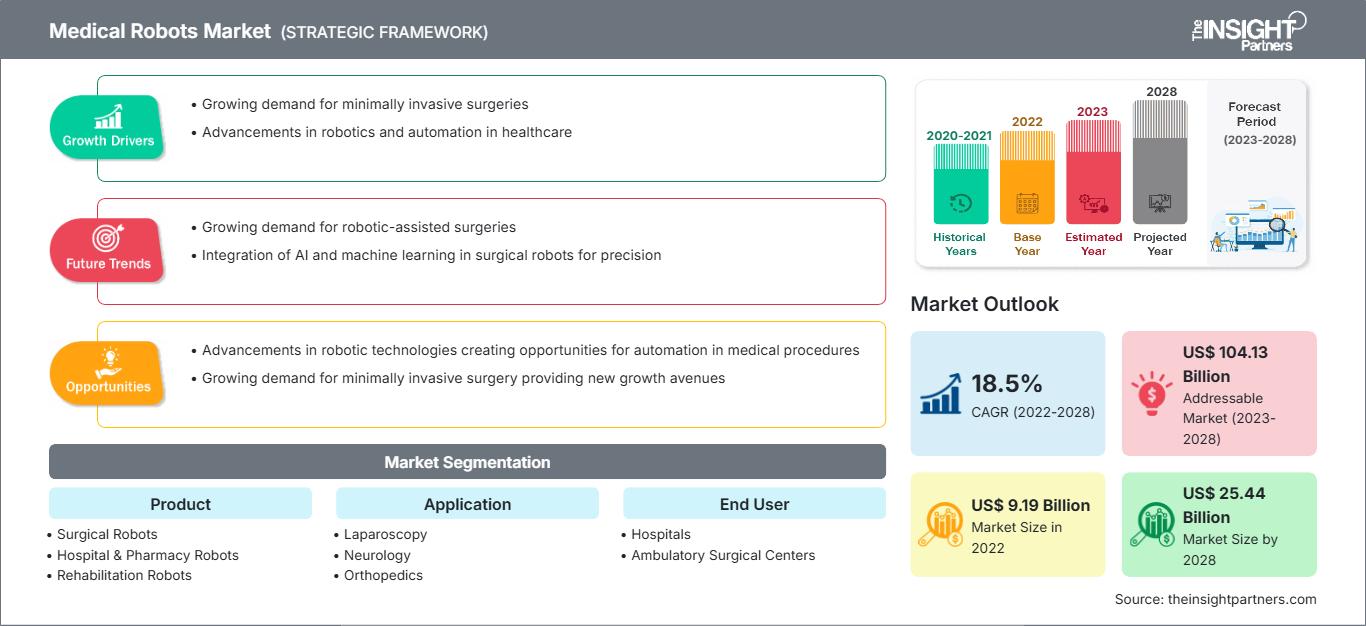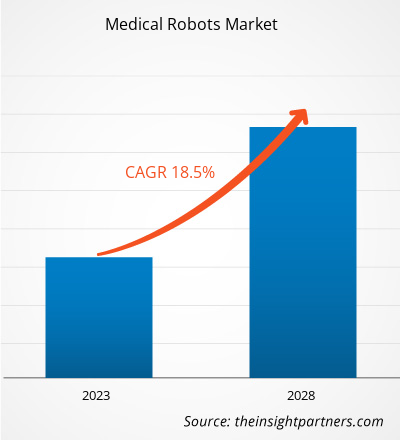预计到 2028 年,医疗机器人市场规模将从 2022 年的 91.897 亿美元增至 254.4336 亿美元;预计 2022 年至 2028 年的复合年增长率为 18.5%。
预计外科手术数量的增加以及产品发布和获批数量的增加将推动医疗机器人市场的发展。然而,外科手术和安装的高成本阻碍了市场的增长。
医疗机器人专为专门的医疗应用而设计。这些机器人可以执行各种医疗任务,例如手术、医学测试和患者监护。它们可以完全根据外科医生的术前计划进行手术。医疗机器人能够实现高精度的开放手术和微创手术。它们还能显著缩短手术所需的时间。此外,医疗机器人还可用于将患者从医院的一个位置运送到另一个位置。用于远程护理的机器人、用于减少医院内感染的消毒机器人以及用于康复训练的机器人外骨骼(提供外部支持和肌肉训练)都是医疗机器人应用的例子。医疗保健领域的机器人技术首次使用于 1985 年,尽管直到 2000 年达芬奇机器人才获得美国 FDA 批准用于执行外科手术。达芬奇机器人因其在心脏外科手术、头颈外科和泌尿外科手术中的应用而广为人知。
在预测期内,北美可能会主导医疗机器人市场。美国在 2022 年占据了北美市场的最大份额,预计在预测期内将继续保持这一趋势。根据美国代谢和减肥外科学会在 2022 年发布的一项研究,在过去十年中,美国的减肥手术增长了约 62.0%。此外,根据美国医疗保健研究与质量局 (Agency for Healthcare Research and Quality) 2017 年发布的研究,美国每年约有 70 万例全膝关节置换手术。如此庞大的手术量预计将为先进医疗设施的采用创造有利环境,从而推动预测期内美国医疗机器人市场的发展。
自定义此报告以满足您的要求
您将免费获得任何报告的定制,包括本报告的部分内容,或国家级分析、Excel 数据包,以及为初创企业和大学提供超值优惠和折扣
医疗机器人市场: 战略洞察

- 获取本报告的主要市场趋势。这个免费样本将包括数据分析,从市场趋势到估计和预测。
您将免费获得任何报告的定制,包括本报告的部分内容,或国家级分析、Excel 数据包,以及为初创企业和大学提供超值优惠和折扣
医疗机器人市场: 战略洞察

- 获取本报告的主要市场趋势。这个免费样本将包括数据分析,从市场趋势到估计和预测。
医疗机器人市场根据产品、应用、最终用户和地域进行细分。按地域划分,市场大致分为北美、欧洲、亚太地区、中东和非洲以及南美和中美洲。医疗机器人报告提供了对市场的深入洞察和分析,强调了市场趋势、技术进步、市场动态以及全球领先市场参与者的竞争分析等参数。
市场洞察
外科手术数量众多全球外科手术数量有所增加。过去 25 年,欧洲国家的心血管疾病发病率有所上升。在该地区,糖尿病病例的增加和生活方式的改变正在增加心血管手术和普通手术的数量。
癌症和糖尿病是全球死亡的主要原因之一。根据美国癌症协会 (ACS) 的一项研究,2021 年美国新增癌症病例约 190 万例。根据荷兰癌症登记处的数据,2021 年荷兰登记的癌症新病例约为 123,672 例。此外,根据国际糖尿病联合会 (IDF) 的数据,2021 年全球糖尿病患者人数估计为 5.37 亿,预计到 2045 年将达到 7.83 亿。
根据美国代谢和减肥外科学会发布的研究,2019 年美国进行了约 252,000 例减肥手术。外科手术数量的增加带来了对机器人手术器械的需求。因此,慢性病的惊人患病率和外科手术数量的增加产生了对机器人手术器械的需求。
产品洞察
基于产品,全球医疗机器人市场细分为手术机器人、康复机器人、非侵入性放射手术机器人、医院和药房机器人等。手术机器人细分为神经外科机器人系统、心脏病外科机器人系统、腹腔镜手术机器人系统和骨科手术机器人系统。2022 年,手术机器人细分市场占据了最大的市场份额。机器人手术是使用机器人手术系统进行的外科手术。手术机器人是自动化和计算机控制的医疗设备,经过编程可协助定位和操纵手术器械,这些手术机器人可帮助外科医生执行复杂的外科手术。这些机器人能够增强外科医生执行开放手术的能力。因此,手术机器人可以通过微创方式执行复杂而先进的外科手术,并且精度更高。不过,预计康复机器人领域在预测期内的复合年增长率最高。
应用洞察
根据应用,全球医疗机器人市场细分为腹腔镜、神经内科、骨科、妇科、泌尿科、心脏病科等。2022 年,腹腔镜手术领域占据了最大的市场份额。不过,预计神经内科领域在预测期内的复合年增长率最高。腹腔镜检查是一种用于检查腹部内器官的外科诊断程序。机器人手术是一种微创手术,只需要小切口,风险低。2000 年,达芬奇手术系统成为 FDA 批准用于一般腹腔镜手术的第一个机器人手术系统。最新的高端型号是 da Vinci Xi。医疗机器人的应用提高了腹腔镜手术的效率。2022 年 1 月,一台机器人在无需人工引导的情况下对一头猪的软组织进行了腹腔镜手术。随着医疗领域越来越多地采用腹腔镜手术方法,拥有一个专门为此类手术设计的自动化机器人系统来辅助手术将变得至关重要。近年来,腹腔镜手术越来越受青睐的主要原因之一是医疗保健行业逐渐从开放手术转向其他手术。由于上述所有因素,腹腔镜手术市场在未来几年可能会继续增长。
最终用户洞察
根据最终用户,全球医疗机器人市场细分为医院、门诊手术中心和其他。2022 年,医院占据了最大的市场份额。此外,由于医疗机器人在外科手术中的医疗优势、应用率的提高以及其在外科手术中性能的提升,预计该细分市场在预测期内将实现最高的复合年增长率。
产品发布和合作是全球医疗机器人市场参与者广泛采用的策略,旨在扩大其全球业务范围和产品组合。参与者还注重合作战略以扩大客户群,这反过来又使他们能够在全球范围内维护其品牌。他们旨在通过开发创新产品来扩大市场份额。以下列出了一些近期的关键市场发展:
- 2022年2月,Capsa Healthcare,一家为医院、长期护理和零售药房提供商提供医疗保健交付解决方案的领先创新者,收购了Humanscale Healthcare,后者是一家位于纽约州纽约市的灵活技术解决方案和计算工作站的设计者和制造商。
- 2022年1月,Omnicell, Inc.推出了Reimaging IV Station,这是一款全自动静脉注射配药机器人,可正面解决行业问题,同时提供患者安全、准确性、成本节约、供应链控制和合规性优势。
- 2021年10月,Accuray推出了精准治疗计划系统,使用户能够轻松计划、优化质量并高效提供治疗。VOLO Ultra是该计划解决方案Accuray精准治疗计划系统的最新发展。它有助于加速Radixact和TomoTherapy的治疗,使临床医生每天可以治疗更多患者。它包含一个最先进的优化器,该优化器采用现代快速的基于梯度的算法,可为每种治疗提供最佳的计划质量。
- 2021 年 6 月,ARxium 在里尔大学医院推出了一款名为“RIVA”的机器人,用于准备注射化疗药物。
医疗机器人市场区域洞察
The Insight Partners 的分析师已详尽阐述了预测期内影响医疗机器人市场的区域趋势和因素。本节还讨论了北美、欧洲、亚太地区、中东和非洲以及南美和中美洲的医疗机器人市场细分和地域分布。
医疗机器人市场报告范围
| 报告属性 | 细节 |
|---|---|
| 市场规模 2022 | US$ 9.19 Billion |
| 市场规模 2028 | US$ 25.44 Billion |
| 全球复合年增长率 (2022 - 2028) | 18.5% |
| 历史数据 | 2020-2021 |
| 预测期 | 2023-2028 |
| 涵盖的领域 |
By 产品
|
| 覆盖地区和国家 | 北美
|
| 市场领导者和主要公司简介 |
|
医疗机器人市场参与者密度:了解其对业务动态的影响
医疗机器人市场正在快速增长,这得益于终端用户需求的不断增长,而这些需求的驱动因素包括消费者偏好的演变、技术进步以及对产品优势的认知度的提升。随着需求的增长,企业正在扩展产品线,不断创新以满足消费者需求,并抓住新兴趋势,从而进一步推动市场增长。

- 获取 医疗机器人市场 主要参与者概述
医疗机器人 - 市场细分
全球医疗机器人市场根据产品、应用和最终用户进行细分。就产品而言,全球医疗机器人市场细分为手术机器人、康复机器人、非侵入性放射外科机器人、医院和药房机器人以及其他。根据应用,全球医疗机器人市场细分为腹腔镜、神经内科、骨科、妇科、泌尿科、心脏病科以及其他。就最终用户而言,医疗机器人市场细分为医院、门诊手术中心和其他。
公司简介
- Intuitive Surgical, Inc.
- Stryker Corporation
- Hocoma AG
- Medtronic
- Auris Health, Inc.
- Accuray Incorporated
- Omnicell Inc.
- Arxium
- Ekso Bionics Holdings, Inc.
- Kirby Lester LLC.
- 历史分析(2 年)、基准年、预测(7 年)及复合年增长率
- PEST和SWOT分析
- 市场规模、价值/数量 - 全球、区域、国家
- 行业和竞争格局
- Excel 数据集
近期报告
相关报告
客户评价
购买理由
- 明智的决策
- 了解市场动态
- 竞争分析
- 客户洞察
- 市场预测
- 风险规避
- 战略规划
- 投资论证
- 识别新兴市场
- 优化营销策略
- 提升运营效率
- 顺应监管趋势




















 获取免费样品 - 医疗机器人市场
获取免费样品 - 医疗机器人市场